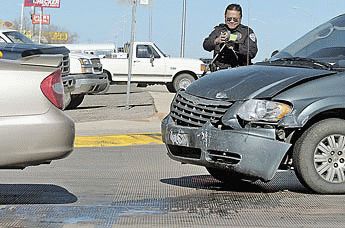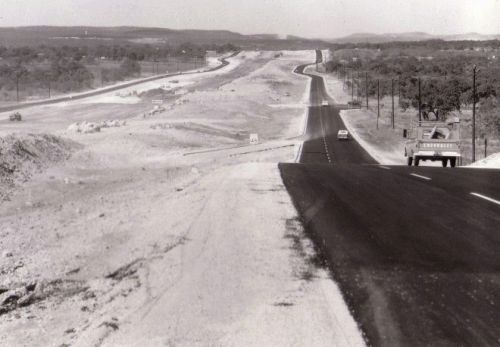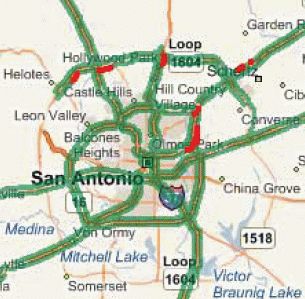It happens to the best of us
 I’m a good driver. No, really, I am. I do all the things good drivers do: I try to predict what other motorists are going to do and plan accordingly (and I’m right most of the time, no small feat in this town); I keep an eye far enough down the road so as to see hazards well in advance; I know traffic laws inside-and-out and obey them (OK, except maybe for a few mph over the speed limit); I yield the right-of-way to bozos who aren’t paying attention or just don’t care; and so on. But last Friday I did something I’ve seen dozens of others do and something that I’m usually very aware of and am careful to avoid, and the result was a lovely fender bender.
I’m a good driver. No, really, I am. I do all the things good drivers do: I try to predict what other motorists are going to do and plan accordingly (and I’m right most of the time, no small feat in this town); I keep an eye far enough down the road so as to see hazards well in advance; I know traffic laws inside-and-out and obey them (OK, except maybe for a few mph over the speed limit); I yield the right-of-way to bozos who aren’t paying attention or just don’t care; and so on. But last Friday I did something I’ve seen dozens of others do and something that I’m usually very aware of and am careful to avoid, and the result was a lovely fender bender.
Of course, the first question folks ask is if anyone was hurt. Fortunately, everyone was fine– in fact, the airbags didn’t even deploy. So the next question, then, is what happened?
What happened to me has probably happened to most motorists at one time or another. I was making a right turn and there was a vehicle stopped in front of me waiting for a gap in the traffic. A gap came along and the vehicle in front of me started moving forward, so I started looking back for a gap to merge into. When a break came along a few seconds later, I started to accelerate only to realize that the car in front of me didn’t actually go when I thought they did. I hit the brakes hard but it was already too late. BAM!
Of course, the way to avoid this is to always look forward again at where you’re going before you start to accelerate, not only to make sure the preceding vehicle has cleared, but also to make sure that another previously unseen vehicle, pedestrian, bicyclist, UFO, or whatnot hasn’t suddenly appeared in your path. I usually do this, but this time I was in a hurry and, as a result, was a little careless.
So hopefully my story will help someone else avoid this all-too-common traffic mistake and the unfortunate results it can bring.
Laws and policies Roads Transit: MPO public meeting
by Brian
Comments Off on MPO holding public meetings for 4 year plan
MPO holding public meetings for 4 year plan
 The San Antonio-Bexar County Metropolitan Planning Organization (MPO) will be holding three public meetings on its 2011-2014 Transportation Improvement Program (TIP). Essentially, this is the revolving list of local transportation projects that are proposed to be funded* over the next three four years (yes, I can count <g>). The projects selected are typically a subset of those in the current long-range plan. Obviously, what eventually does get funded depends heavily on what money eventually comes to this area, but this plan identifies the projects that are first in line to get whatever funding becomes available. The plan includes allocations for all forms of transportation including highways, streets, transit, and bike and pedestrian amenities.
The San Antonio-Bexar County Metropolitan Planning Organization (MPO) will be holding three public meetings on its 2011-2014 Transportation Improvement Program (TIP). Essentially, this is the revolving list of local transportation projects that are proposed to be funded* over the next three four years (yes, I can count <g>). The projects selected are typically a subset of those in the current long-range plan. Obviously, what eventually does get funded depends heavily on what money eventually comes to this area, but this plan identifies the projects that are first in line to get whatever funding becomes available. The plan includes allocations for all forms of transportation including highways, streets, transit, and bike and pedestrian amenities.
The MPO is the agency charged under state and federal law to control the transportation funding purse-strings for the San Antonio urban area, which in this case includes Bexar County and portions of Comal and Guadalupe counties in the Schertz area. The TIP is required under federal regulations as a condition of receiving federal funding. Projects not in the TIP cannot use federal funds, so this is an important process.
There will be three meetings, all with identical content:
- Tuesday, May 4th from 5:00 p.m. to 8:00 p.m.
- Thursday, May 6th from 11:30 a.m. to 1:30 p.m.
- Saturday, May 8th from 9:00 a.m. to noon
All three will take place at VIA Metro Center on San Pedro just south of SAC. Visitors will also be able to check-out some new interactive systems and discuss the transportation planning process with the folks that make these decisions.
For more information and to see a draft copy of the TIP, click here. Also, see the interactive site here (link added 5/4/10 10:35 am).
(* As I’ve discussed before vis-a-vis the US 281 project, the term “funded” in transportation parlance means that anticipated revenues during the plan timefame will be able to fund a project. Until those revenues are actually allocated to the MPO, a project does not actually have money available to start work.)
My days at the TxDOT photo archive

I-10 south of De Zavala looking north, 1966 (TxDOT archive)
After returning from my Florida vacay a couple of weeks ago, I spent the balance of my time off of work at the TxDOT archive in Austin. I had been wanting to go for years after seeing some of the great historical photos from there on other roadgeek websites. I was not disappointed.
Three, two, one… liftoff!
For a long time, my wife and I have wanted to see the launch of a Space Shuttle. With the Shuttle program winding-down this year, we realized a couple of months ago that it was do-or-die time, so a little over a week ago, we packed-up our 18-month-old and headed down to Florida to see the April 5th launch, what is likely to be the last nighttime launch of a Space Shuttle. And wow, am I glad we did.
WTF? Oh, it’s a FYA!

“What the heck is that?!”
That seems to be a common reaction of local motorists as they first encounter one of the flashing yellow arrow (FYA) traffic signals that have popped-up at San Antonio intersections over the past year or so. What began as an experiment in late 2008 at a couple dozen intersections along Wurzbach Rd. and San Pedro Ave. has now spread to about 40 or so intersections across the city and will now become a standard, not just here in San Antonio, but nationally as mandated by the federal Manual on Uniform Traffic Control Devices (MUTCD). As often happens in these cases, there has been some second-guessing amongst the general public as to the necessity of this newfangled signal, but understanding the research that went into it and why it’s beneficial generally allays those knee-jerk criticisms.
Tragedy provides reminders
It’s been over two weeks now since the accident that killed Rosita Davila. According to reports, off-duty SAPD officer Gabe Trevino was entering Loop 1604 westbound near Stone Oak after midnight that night and collided with a car being driven by Davila, causing her car to skid off the roadway and flip over the center barrier, killing her and injuring a passenger.
This tragedy serves as a tragic reminder of two important traffic laws, both of which have been a focus of the initial investigation. Firstly, drivers entering a freeway must yield to traffic already on the freeway. Inexplicably, I’ll get an e-mail from time-to-time from someone who firmly believes that traffic entering the freeway has the right-of-way unless there’s a yield sign (which is fairly rare.) However, traffic entering a freeway is considered to be changing lanes, and you must always yield to traffic already in a lane into which you’re merging.
Secondly, all drivers have a fundamental duty to do everything they reasonably can to avoid an accident. I can’t count how many times I’ve seen drivers forcibly assert their right-of-way and nearly cause an accident. Please understand that I’m not saying that’s what happened in this case, but the initial accident report did proffer that as a possible cause, and even if it’s moot, it still offers a reminder that’s it’s entirely possible to be “dead right.”
It has recently been reported that Trevino was texting or otherwise using his cell phone at the time of the accident. The dangers of this are obvious, and again, this case offers yet another reminder. If not, take a look at the new AT&T ads about texting while driving:
http://fastlane.dot.gov/2010/03/new-antitexting-campaign-breaks-hearts-and-unsafe-habits.html
INRIX: Congestion in SA slightly worse

Top 10 SA-area bottlenecks (in red)
Traffic data services company INRIX’s annual “National Traffic Scorecard” was released a few weeks ago, and it shows that traffic congestion in San Antonio increased slightly over the past year.
This year, San Antonio ranked 25th in the nation in terms of overall traffic congestion. After flip-flopping with Houston last year, the Dallas-Ft. Worth area regained the title as Texas’ most congested region, landing at the number five spot nationally. Houston was sixth, and Austin was 23rd. The Los Angeles area was tops.

